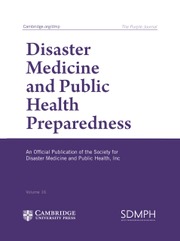Stampedes are tragic events that occur due to overcrowding, commonly at religious gatherings, which are accountable for nearly 64% all the fatalities and ~51% of injuries. Factors categorized as fire, rumors, structural failure, and narrow passages are the major triggering factors, followed by overcrowding and rumors.Reference Vanumu, Laxmikant and KR 1 Stampedes are not just accounted as disastrous accidents, but their consequences extend beyond immediate fatalities, encompassing life-threatening impacts on physical injuries, mental suffering, and also a huge strain on public health care infrastructures. Stampedes are showing huge gaps in emergency preparedness along with the crowd management system in India. In the last 5 years, about 10-12 stampedes have happened in India. In the year 2025 itself, almost seven or more such panic-driven movements happened. 2 , 3
One of the world’s largest religious congregations – Maha Kumbh 3 – has also witnessed a tragic stampede in January 2025, resulting in the loss of approximately 30 lives and leaving nearly 60 or more individuals injured. Another massive incident at Hathras (Uttar Pradesh) Satsang (religious gathering), 3 on July 2, 2024, where almost 121 people died, including women and children. In 2025, India`s GDP expanded by 7.4% compared to the previous year.
Several countries around the world have implemented successful strategies to prevent stampedes during massive crowd events, offering valuable learnings for India. We should take examples from other nations. For example, Saudi Arab 4 authorities setting a global benchmark by developing platforms like Sawaher which employs artificial intelligence and multi-camera feeds for real-time monitoring, enhancing security by advancing the crowd management system, similarly, Germany 5 during any large events like Oktoberfest use AI-powered tools, Queue Management, Incident Detection and Response system and crowd video analytics models to plan and regulate walking pedestrians’ routes and prevent overcrowding.
QatarReference Elbanna, Elsharnouby, Aljafari and Fatima 6 used a combination of strategies such as AI-based monitoring system, abnormal events detection (AED), real-time crowd management system, powered surveillance, face recognition, digital ticketing, and sensor-sensitive cameras to detect violent behaviors in crowds during an organized international event like the FIFA World Cup 2022, which was attended by millions of people. Authorities. Japan, a country well known for disaster preparedness and public health emergency management, 7 employs a mathematical approach for crowd control using advanced integrated technology during the New Year shrine festival.
India should promote more awareness and provide training or instruction on safety protocols to devotees. More audits and safety drills should be conducted before organizing any massive events. The government should allocate more budget to Disaster Management Authorities for preparedness and response planning. Furthermore, investment in advanced technology such as AI-based tools, smart surveillance and real-time alert systems, public health relief centers, and the development and implementation of technology-enabled disaster risk reduction strategies would be required to make India a stampede-free and disaster-resilient country. Furthermore, the central and state governments should come up with appropriate legislation for management of crowds at religious, stadium, and other places. Such law should also prescribe the maximum limit of people to be allowed at various places to manage crowds efficiently and avoid stampedes.
Author contribution
MG and MS conceptualized the article and also wrote, and DVM revised and provided intellectual feedback.
Competing interests
None.

